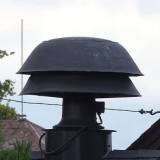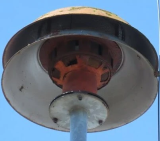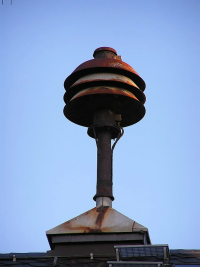Type Fm Si
The Type Fm Si (German: Typ Fm Si) was a group of omnidirectional electromechanical sirens produced by Siemens-Schuckert from the mid-to-late 1920s to 1945. The Type Fm Si group ranges from tiny industrial alarms to large dual-rotor air raid sirens. Although successful during their production lifespan, a dwindling number of these sirens now remain.
Despite popular misconception, the number prefix attached to the siren's name does not correlate to the year of the siren's introduction.
Design
Type Fm Si 28
The Type Fm Si 28 (German: Typ Fm Si 28) is a medium sized omnidirectional electromechanical siren. It makes use of an 8-port rotor and stator driven by a likely 5 kW (6.7 hp) motor, which is enclosed in a cylindrical housing. A removable service panel is located on the midsection of the housing, which allows for easier maintenance. 4 support struts bolted to the motor housing hold up a triangular shroud that shields the siren from the elements, also serving the dual purpose of deflecting the siren's sound downwards. Very little else is known about the siren, as very few units remain and no documentation is known to exist.
Type Fm Si 29
WIP
Type Fm Si 30
WIP
Type Fm Si 36
The Type Fm Si 36 (German: Typ Fm Si 36) is a small omnidirectional electromechanical industrial siren and is similar to Elektror's S1 and S2. It is a simple siren in terms of design, consisting of an 8-port rotor and stator driven by a 220 V 100 W motor, located below the rotor and stator assembly. A mesh screen is wrapped around the ports to prevent injury from misuse of the siren, as it is small enough to be handheld. A circular plate with 4 struts connected to it holding up a triangular rain shield is bolted to the top of the stator. Another mesh screen is wrapped around the struts to prevent injury. Very little else is known about the siren.
Type Fm Si 38
The Type Fm Si 38 (German: Typ Fm Si 38) is a small omnidirectional electromechanical industrial siren and is similar to Elektror's S1 and S2. It is a simple siren in terms of design, consisting of a 6-port rotor and stator driven by a 220 V 100 W motor, located below the rotor and stator assembly. As it was likely primarily intended for indoor use, it is completely unprotected from the elements, minus a mesh screen wrapped around the stator as well as the intake, which prevents debris from entering the rotor or injury from misuse of the siren. Very little else is known about the Type Fm Si 38, and few units are known to exist, with most in the hands of private collectors.
Type Fm Si 39
The Type Fm Si 39 (German: Typ Fm Si 39) is a medium-sized omnidirectional electromechanical siren. The siren makes use of a 3-port "woofer"/"tiefton" rotor and stator, driven by a 5 kW (6.7 hp) 200/380 V motor below the rotor and stator assembly which either ran on 3 ph or DC power, with 3 ph units having an "a" suffix and DC units having a "b" suffix. Units with their motor above the rotor and stator also exist. The motor spins the rotor at around 3000 rpm. A cylindrical base is located below the motor and allows the siren to be bolted to a flat surface. Units with motors above the rotor and stator utilize 4 support struts mounted to a base instead. 2 louvers are attached to the siren, with the top one being held up above the rotor via 3 support struts, acting as a rain shield, and the bottom one being bolted to the top of the stator, deflecting the siren's sound downward. Units with motors above the rotor and stator only have 1 louver which is bolted to the top of the stator. A mesh screen is wrapped around the struts to prevent birds or other animals from entering the intake. With the louvers, the siren weighs around 91 kg (~200 lb). The siren is identical to the Typ Fm Si 41, aside from the port ratio. Together with the Typ Fm Si 41, it formed an Typ Fm Si 40 unit.
Type Fm Si 40
The Type Fm Si 40 (German: Typ Fm Si 40) is a large dual-toned omnidirectional electromechanical siren and is one of the most common sirens in the series. The siren makes use of 2 smaller sirens conjoined into one via 3 support struts: the high-frequency, 8-port tweeter located at the top, the Typ Fm Si 41, and the low-frequency, 3-port woofer/tiefton located at the bottom, the Typ Fm Si 39. Each unit retained their 5 kw (6.7 hp) motors, which could either run on 3 ph or DC power, with 3 ph units having an "a" suffix and DC units having a "b" suffix. These 2 units could be controlled separately; the low tone woofer/tiefton was typically used for fire calls at volunteer fire departments, while the high tone tweeter was used for general alerts and danger. Both sirens operating at once in a wailing tone signaled an incoming air raid. However, today the dual siren operation is usually used for all purposes of surviving active units. 2 louvers are attached to the top and bottom of the tweeter rotor, and 1 is attached to the top of the woofer rotor. Air is sucked in from under the louver at the bottom of the tweeter rotor, allowing for both sides to receive an air intake. The tweeter's motor has a cylindrical base attached to its bottom, allowing for the entire siren to be mounted to 1 singular surface.
Type Fm Si 41

The Type Fm Si 41 (German: Typ Fm Si 41), marketed under the L135 name during World War II, is a medium-sized omnidirectional electromechanical siren, and is one of the most common sirens in the series. The siren makes use of an 8-port "tweeter" rotor and stator, driven by a 5 kW (6.7 hp) 200/380 V motor below the rotor and stator assembly which either ran on 3 ph or DC power, with 3 ph units having an "a" suffix and DC units having a "b" suffix. The motor spins the rotor at around 3000 rpm. 2 louvers are attached to the siren, with the top one being held up above the rotor via 3 support struts, acting as a rain shield, and the bottom one being bolted to the top of the stator, deflecting the siren's sound downward. A mesh screen is wrapped around the struts to prevent birds or other animals from entering the intake. With the louvers, the siren weighs around 91 kg (~200 lb). The siren is identical to the Typ Fm Si 39, aside from the port ratio. Together with the Typ Fm Si 39, it forms a Typ Fm Si 40 unit. Interestingly, Type Fm Si 41 units were sent to Greece during and shortly after World War II and subsequently copied by the Greek company VILMA Motors (at the time ELVIMA) with their "SGL" siren, which was eventually superseded by the NEVA( )55 and later the VILMA( )55.
Type Fm Si 46
WIP
Type Fm Si 49

The Type Fm Si 49 (German: Typ Fm Si 49) is a medium-sized omnidirectional electromechanical siren. The siren makes use of a 12-port rotor and stator, driven by a 5 kW (6.7 hp) 200/380 V motor below the rotor and stator assembly which either ran on 3 ph or DC power, with 3 ph units having an "a" suffix and DC units having a "b" suffix. The motor spins the rotor at around 3000 rpm. The motor has a cylindrical base attached to its bottom, allowing for the siren to be mounted to a flat surface. 2 louvers are attached to the siren, with the top one being held up above the rotor via support struts, acting as a rain shield, and the bottom one being bolted to the top of the stator, deflecting the siren's sound downward. A mesh screen is wrapped around the struts to prevent birds or other animals from entering the intake.
Type Fm Si 61
WIP
Type Fm Si 78

The Type Fm Si 78 (German: Typ Fm Si 78) is a medium-sized omnidirectional electromechanical siren and is one of the most common sirens in the series. The siren makes use of an 8-port "tweeter" rotor and stator, driven by a 5 kW (6.7 hp) 200/380 V motor below the rotor and stator assembly which either ran on 3 ph or DC power, with 3 ph units having an "a" suffix and DC units having a "b" suffix. Several spaces beneath the stator allow for the motor to cool. The motor spins the rotor at around 3000 rpm. The motor has a cylindrical base attached to its bottom, allowing for the siren to be mounted to a flat surface. 2 louvers are attached to the siren, with the top one being held up above the rotor via support struts, acting as a rain shield, and the bottom one being bolted to the top of the stator, deflecting the siren's sound downward. A mesh screen is wrapped around the struts to prevent birds or other animals from entering the intake.
Type Fm Si 87
WIP
